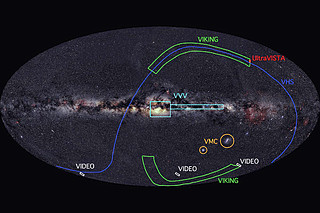The VISTA surveys
 Six large public surveys conducted by VISTA are taking up the majority of the observing time in the telescope’s first five years of operations. The surveys cover different areas of sky to different depths to attack a wide range of scientific questions. One of the surveys will cover the entire southern hemisphere of the sky.
Six large public surveys conducted by VISTA are taking up the majority of the observing time in the telescope’s first five years of operations. The surveys cover different areas of sky to different depths to attack a wide range of scientific questions. One of the surveys will cover the entire southern hemisphere of the sky.
UltraVISTA
This is the deepest and narrowest VISTA survey. It is imaging one patch of sky over and over again to unprecedented depths. The science goals of UltraVISTA include studying the first galaxies, understanding the stellar mass build-up during the peak epoch of star formation activity and dust-obscured star formation.
VIKING: VISTA Kilo-Degree Infrared Galaxy Survey
The VIKING survey is imaging 1500 square degrees. The near-infrared data is being used in the determination of very accurate distance estimates for remote galaxies based on their colours. Other science drivers include the hunt for high-redshift quasars, galaxy clusters, and the study of galaxy stellar masses.
VMC: VISTA Magellanic Survey
This survey is imaging 184 square degrees covering our nearby neighbouring galaxies: the Large Magellanic Cloud, the Small Magellanic Cloud and their environment in several near-infrared colours. Observations at different times are also allowing the study of many variable stars. The survey will be used to study resolved stellar populations, to investigate the star formation history of the system and to trace its three-dimensional structure.
VVV: VISTA Variables in the Via Lactea
The VVV survey is targeting the central parts of our galaxy in five near-infrared bands. The total area of this survey is 520 square degrees and contains more than 355 open and 33 globular clusters. The VVV is multi-epoch in nature in order to detect a large number of variable objects and will provide more than 100 carefully spaced observations at different times for each part of the sky covered. A catalogue with about a billion point sources including about a million variable objects is being created These will be used to create a three-dimensional map of the bulge of our Milky Way galaxy. Other science drivers include the ages of stellar populations and globular cluster evolution.
VHS: VISTA Hemisphere Survey
The VHS is imaging the entire southern hemisphere of the sky, with the exception of the areas already covered by the VIKING and VVV surveys, in two near-infrared bands as well as some other areas for special purposes. The resulting data are about 4 magnitudes (forty times) deeper than the earlier 2MASS and DENIS surveys. The main aims of the survey are to examine low mass and nearby stars, to study the merger history of our Milky Way, to measure the properties of dark energy through the examination of large-scale structure and to search for high-redshift quasars.
VIDEO: VISTA Deep Extragalactic Observations Survey
VIDEO is a 15 square degree near-infrared multi-colour survey to study galaxy evolution using active galactic nuclei, galaxy cluster evolution, and very massive galaxies. The survey comprises four fields. The width and area of VIDEO are intermediate between the wide, but relatively shallow, VIKING survey and the small, but very deep, UltraVISTA.
More information about the VISTA surveys at: Public Surveys Projects page